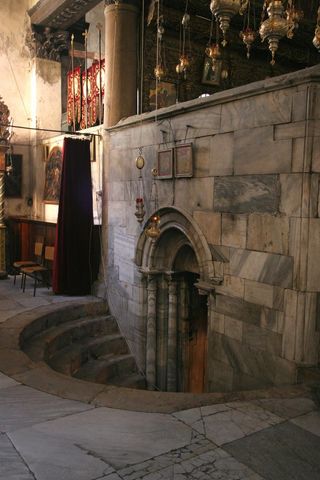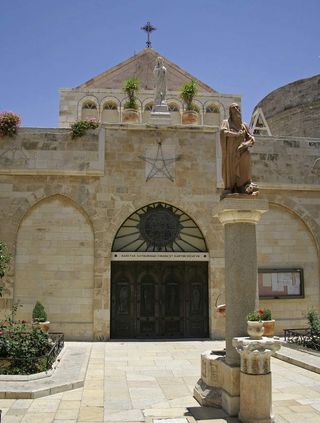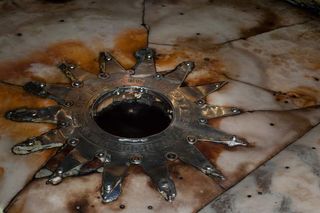Jesus' Birthplace May Become First Palestine World Heritage Site

The holy city of Bethlehem's Church of the Nativity, thought to be the birthplace of Jesus, may become the first World Heritage Site in the Palestinian territories, according to UNESCO.
In its 36th yearly session, the World Heritage Committee — consisting of representatives from 21 of the States Parties to the Convention — will consider 36 possible World Heritage sites, from June 24 to July 6 in Saint Petersburg, Russia.
The list currently includes more than 900 properties deemed by the committee as having "outstanding universal value" as part of the world's natural and cultural heritage.
Palestine, which became a member of UNESCO in October 2011, will be presenting the church and the surrounding route used for religious pilgrimages as its first site for inscription on the World Heritage List. [See Photos of Jesus' Birthplace]

That vote, to accept the Palestinians into UNESCO, proved controversial, according to a CNN news report, suggesting the United States held the view that a peace deal should be reached with Israel before the Palestinian territories were granted full UNESCO membership.
Located in the holy city of Bethlehem, the Church of the Nativity, a Byzantine basilica, is built on top of the cave where, according to a tradition first documented in the second century, Jesus was born, UNESCO notes. Helena, mother of Christian Emperor Constantine, is said to have intended the basilica to commemorate Jesus' birth.
The church was one of three imperial churches built in Palestine under the Christian emperor. In A.D. 529, the church was destroyed and built on a much bigger scale, essentially the church that stands today.
Sign up for the Live Science daily newsletter now
Get the world’s most fascinating discoveries delivered straight to your inbox.
The part of the church with the greatest religious and historical significance is arguably the Grotto of the Nativity, according to a description of the church written by Qustandi Shomali, a professor at Bethlehem University. Two entrances now lead to the grotto where an altar was erected over Jesus' birthplace and a 14-pointed star was embedded in the white marble floor to mark the spot where Jesus was born. The star bears a Latin inscription: "Hic De Virgine Maria Jesus Christus Natus" Est - 1717, translated as, "Here Jesus Christ was born to the Virgin Mary."

"The universal outstanding value of Bethlehem is unquestionable," UNESCO officials write. "It has been, and continues to be, a focus of Christian belief and worship throughout the centuries. Bethlehem, as well as Jerusalem, became the heart of the Christian world."
The UNESCO website goes on to note the most widely celebrated religious celebration is based on the birth of Jesus.
And at the end of the day, there's just one birthplace for the Christian deity. "There is no other site in the world that bears such an exceptional outstanding religious value for more than 2 billion Christians," UNESCO writes. "There is only one site in the world that has the honor of being the birthplace of Jesus."
The basilica's nomination as a World Heritage Site is not without concern, of course. In addition to political reservations, the church has been damaged by several earthquakes and is administered by three religious groups — the Greek Orthodox, Armenian and Roman Catholic churches — whose tensions have occasionally flared into violence, according to CNN.
A UNESCO spokeswoman Susan Williams, quoted by CNN, said the committee would make its decision on the church and other sites "based on the information that is provided by the expert bodies, and the different presentations that are made." As such, she couldn't predict the outcome of the meeting. "If the committee approves, it's a done deal," CNN reports Williams saying.
Follow LiveScience on Twitter @livescience. We're also on Facebook & Google+.
Jeanna Bryner is managing editor of Scientific American. Previously she was editor in chief of Live Science and, prior to that, an editor at Scholastic's Science World magazine. Bryner has an English degree from Salisbury University, a master's degree in biogeochemistry and environmental sciences from the University of Maryland and a graduate science journalism degree from New York University. She has worked as a biologist in Florida, where she monitored wetlands and did field surveys for endangered species, including the gorgeous Florida Scrub Jay. She also received an ocean sciences journalism fellowship from the Woods Hole Oceanographic Institution. She is a firm believer that science is for everyone and that just about everything can be viewed through the lens of science.
Most Popular



